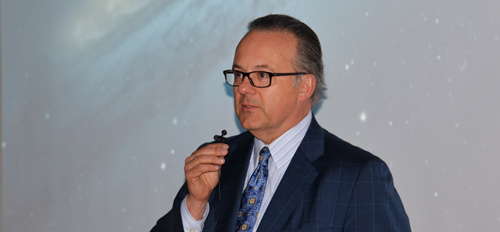
What if a technology that already helps patients could also help the United States achieve the “Cancer Moonshot” launched by former Vice President Joe Biden? Ronald Warnick, MD, a neurosurgeon with Mayfield Brain & Spine, recently addressed that possibility in a guest column in U.S. News & World Report.
The Moonshot, which echoes the ambition of President Kennedy’s original Moonshot 50 years ago, calls for scientists, engineers, and computer scientists to come together and develop new ways to prevent, diagnose, and treat cancer. The federal government is providing $1.8 billion to make it happen.
In his guest editorial, Dr. Warnick says we have life-saving tools and technologies right now that can help us achieve this heroic goal. Those existing technologies include radiotherapy, immunotherapy, and big data.
Read Dr. Warnick’s complete article in U.S. News & World Report >
“Radiotherapy, a mainstay for treating and managing many types of cancer, has already helped millions of patients by disrupting the DNA of cancer cells and halting tumor growth,” writes Dr. Warnick. “We can further harness this treatment approach to achieve a number of the Moonshot’s objectives and help people everywhere who are battling cancer.”
Dr. Warnick has been part of the transformation in how radiotherapy is delivered to patients whose cancer has spread (metastasized) from the lung or breast to the brain. In years past, doctors radiated the entire brain, impacting healthy tissue and risking patients’ ability to think and remember. Today, stereotactic radiosurgery allows highly focused beams of radiation to be delivered directly to metastatic tumors, sparing healthy tissue.
“Stereotactic radiosurgery has dramatically improved clinical outcomes and patient experiences,” Dr. Warnick writes. “Gamma Knife, one of the most commonly used platforms for stereotactic radiosurgery, has already been used to treat more than one million patients worldwide.”
Combining radiotherapy with other technologies, such as immunotherapy, carries even more promise, Dr. Warnick writes. Immunotherapy, which involves treatments that rev up the body’s immune system to fight cancer, is a key priority of the Cancer Moonshot.
Proof is already emerging that treatment with both immunotherapy and radiotherapy is beneficial. A recent study of patients with malignant melanoma found that those treated with both an immunotherapy drug and radiotherapy survived 21.3 months longer (on average) than those treated only with radiotherapy. “We must continue to evaluate a combination of therapies to understand how they might work together,” Dr. Warnick writes.
The Cancer Moonshot will also involve the use of big data to help doctors and researchers understand which treatments work best for individual patients. In this arena, too, radiotherapy is already contributing.
“In 2014 the American Association of Neurological Surgeons and the American Society for Radiation Oncology initiated a national registry for patients treated with stereotactic radiosurgery,” Dr. Warnick writes. “The registry involves 30 clinical sites where researchers are gathering treatment and outcomes data for thousands of patients. The data will be used to define national patterns of care and refine treatment for individual patients, helping to ensure that future patients receive optimal treatment.”
In conclusion, Dr. Warnick writes that the Cancer Moonshot is launching from a proven platform of success. He is confident that radiotherapy will benefit the patients of tomorrow when it is used alone, when it is used in conjunction with other emerging technologies, and when it is paired with big data to provide the most precise blueprint for treatment imaginable.